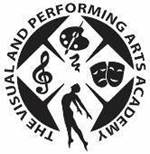
Sharon Byrd, Coordinator
The Visual and Performing Arts Academy (VPAA) offers the opportunity for students who have an interest in the arts to select courses that prepare them for post-secondary advanced studies or entry into arts-related occupations. The balance between artistic development and academic preparation is at the heart of the Academy program. Students are exposed to the humanities and have the opportunity to select a course of study that will best meet their needs and interests.
The Academy is organized into five strands: visual art, instrumental music, vocal music, dance, and theatre. Students will view each strand through the lens of four components: aesthetic perspectives, creative expression, culture and history, and analysis and critique. Given that arts exploration is a guiding philosophy of the Academy, all students are encouraged to avail themselves to a variety of arts. All strands emphasize performance and exhibition. Literacy is incorporated across the curriculum. In addition, students enrolled in the Academy explore the cultural influences within the arts and the impact of the arts on history.
The music program is divided into two strands-instrumental and vocal. Both strands focus on developing a student's understanding of music concepts, with a strong emphasis in pedagogy through ensemble and technique, that serve as a foundation for literacy, performance, and the maturation of aesthetic judgment.
Students will apply knowledge and understanding of the elements of style, form, and cultural expression inherent in music. The student's understanding of musical concepts is developed through focus on a comprehensive variety of musical styles in which they compare and contrast social, ethnic, and cultural influences on music. Students become scholars of music. As students learn about the characteristics and individuals relevant to each area and time period of music studied, they internalize the concepts and, as a result, are able to produce musically expressive performances. In both music strands, students explore career possibilities in music education and performance. Music students develop the skills that will provide them with a life-long love and appreciation of music and the Arts, thus creating passionate and literate advocates for the Arts.
The visual arts strand provides a concept-based instructional approach to student learning. Through fine art studio and career-based courses, students have a wide range of opportunities to grow in visual communication, content knowledge and context, technique and design, and critical and creative thinking. Students will be exposed to and participate in a variety of real-world artistic experiences, thorough college preparation, field trips and master-class artist workshops. Sketchbooks, collaboration, thesis research, and social connections are ways that students will explore various subject matter and mediums, while making connections with their own art and works of contemporary or historical significance.
Students taking classes in the dance strand develop an awareness of the body as an instrument of expression. They refine their skills in dance technique and choreography and increase their ability to move creatively and spontaneously. Exposure to great works of art allows students to analyze the special characteristics of noted performers, choreographers, critics, and impresarios, as well as understand how these individuals have shaped the history of dance.
Students in the theatre strand develop a broad worldview of theatre while learning to create, analyze, perform, and critique dramatic performances. Students study and practice various contemporary acting techniques in a rigorous and performance-based classroom. Students also learn elements of technical theatre including design and application of scenery, properties, lighting, sound, costumes, makeup, and stage management.
All coursework incorporates concepts that extend to film, television and electronic media.
Course of Study
“Inspiration, Vision, Creation, and Realization” is the theme of the Visual and Performing Arts Academy. The Academy is designed to:
- Offer a strands curriculum of differentiated instruction in the arts;
- Develop individual talent and interest;
- Instill an increased awareness of cultural literacy and the value of the arts in society; and
- Provide varied opportunities for performance and exhibition.
Students may earn either an Advanced Studies Diploma or a Standard Diploma based on the options available in the various curricula. Core courses are required of all students in the Academy and include English, mathematics, science, and social studies. During freshman, sophomore, and junior year students take two academy credits each year. Most students focus on one strand of the arts and have the option to take courses in more than one of the five strands. During their senior year, all students take a course entitled, “Senior Synthesis.” This course culminates with the Academy Senior Arts Festival in late May. Through their four years in the program, students complete master class sessions which are held periodically throughout each school year. These seminars can serve as a basis for an internship as part of the seminar course in the students’ senior year.
Sample Course of Study - Sample Student Schedule
| Grade 9 | Grade 10 | Grade 11 | Grade 12 | |
|---|---|---|---|---|
| Core Courses |
English |
English |
English |
English |
|
World History I |
World History II |
VA/U.S. History |
VA/U.S. Government |
|
|
Science |
Science |
Science |
Science |
|
|
Mathematics |
Mathematics |
Mathematics |
Mathematics |
|
|
Health/Physical Education |
Health/Physical Education |
|
|
|
|
World Language |
World Language |
World Language |
World Language |
|
|
VPAA Arts Course |
VPAA Arts Course |
VPAA Arts Course |
Senior Synthesis |
|
|
VPAA Arts Course |
VPAA Arts Course |
VPAA Arts Course |
VPAA Arts Course |
|
|
|
|
|
Arts Practicum |
